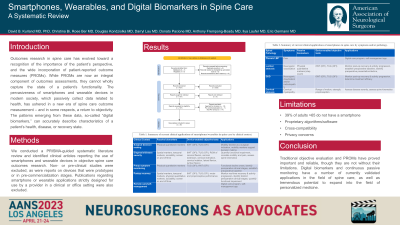Smartphones, Wearables, and Digital Biomarkers in Spine Care, A Systematic Review
Smartphones, Wearables, and Digital Biomarkers in Spine Care, a Systematic Review
Friday, April 21, 2023


David B. Kurland, MD, PhD (he/him/his)
Department of Neurosurgery
NYU Langone Health
New York City, New York, United States
ePoster Presenter(s)
Introduction: Outcomes research in spine care has evolved toward a recognition of the importance of the patient’s perspective, and the wide incorporation of patient-reported outcome measures (PROMs). While PROMs are now an integral component of outcomes assessments, they cannot wholly capture the state of a patient’s functionality. The pervasiveness of smartphones and wearable devices in modern society, which passively collect data related to health, has ushered in a new era of spine care outcome measurement – and in some respects, a return to objectivity. The patterns emerging from these data, so-called “digital biomarkers,” can accurately describe characteristics of a patient’s health, disease, or recovery state.
Methods: We conducted a PRISMA-guided systematic literature review and identified clinical articles reporting the use of smartphones and wearable devices in objective spine care outcomes research. Non- or pre-clinical studies were excluded, as were reports on devices that were prototypes or in pre-commercialization stages. Publications regarding smartphone or wearable applications strictly designed for use by a provider in a clinical or office setting were also excluded.
Results: Our search returned 437 results. Of these, 330 were readily deemed ineligible based on subject matter. Of the remaining 107 sought for retrieval, 37 were excluded based on the exclusion criteria described above. A total of 70 manuscripts met inclusion criteria, and were reviewed. We identified numerous digital biomarkers under present investigation to aid in various aspects of spine care for myriad pathologies, ranging from surgical decision making to remote monitoring of disease states. We summarize our findings in tabular form.
Conclusion : Traditional objective evaluation and PROMs have proved important and reliable, though they are not without their limitations. Digital biomarkers and continuous passive monitoring have a number of currently validated applications in the field of spine care, as well as tremendous potential to expand into the field of personalized medicine.
Methods: We conducted a PRISMA-guided systematic literature review and identified clinical articles reporting the use of smartphones and wearable devices in objective spine care outcomes research. Non- or pre-clinical studies were excluded, as were reports on devices that were prototypes or in pre-commercialization stages. Publications regarding smartphone or wearable applications strictly designed for use by a provider in a clinical or office setting were also excluded.
Results: Our search returned 437 results. Of these, 330 were readily deemed ineligible based on subject matter. Of the remaining 107 sought for retrieval, 37 were excluded based on the exclusion criteria described above. A total of 70 manuscripts met inclusion criteria, and were reviewed. We identified numerous digital biomarkers under present investigation to aid in various aspects of spine care for myriad pathologies, ranging from surgical decision making to remote monitoring of disease states. We summarize our findings in tabular form.
Conclusion : Traditional objective evaluation and PROMs have proved important and reliable, though they are not without their limitations. Digital biomarkers and continuous passive monitoring have a number of currently validated applications in the field of spine care, as well as tremendous potential to expand into the field of personalized medicine.
